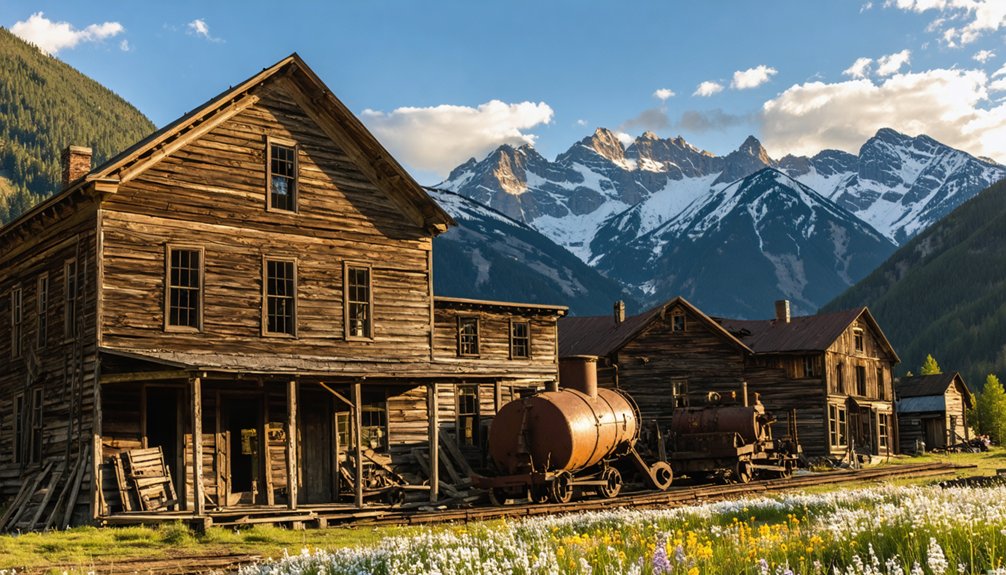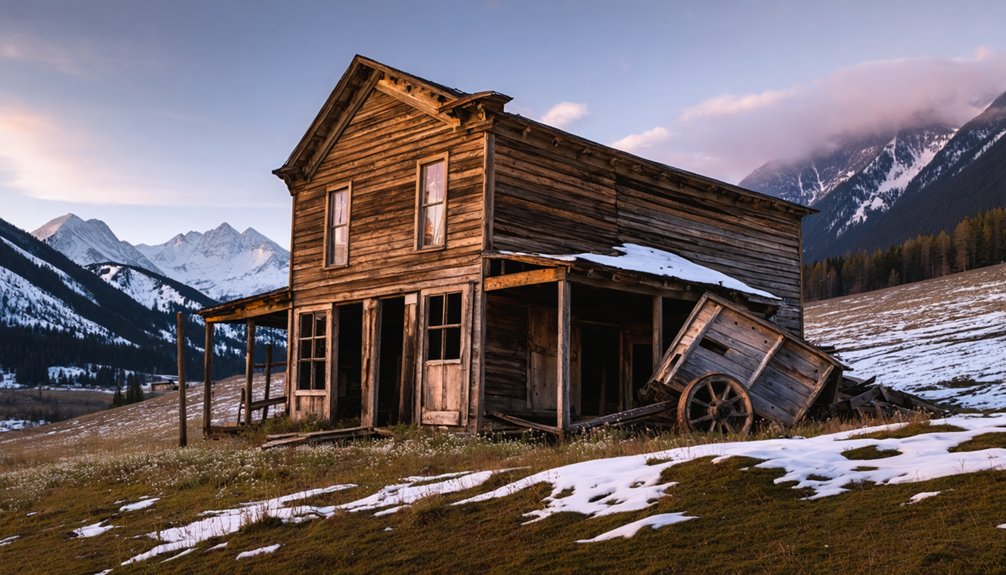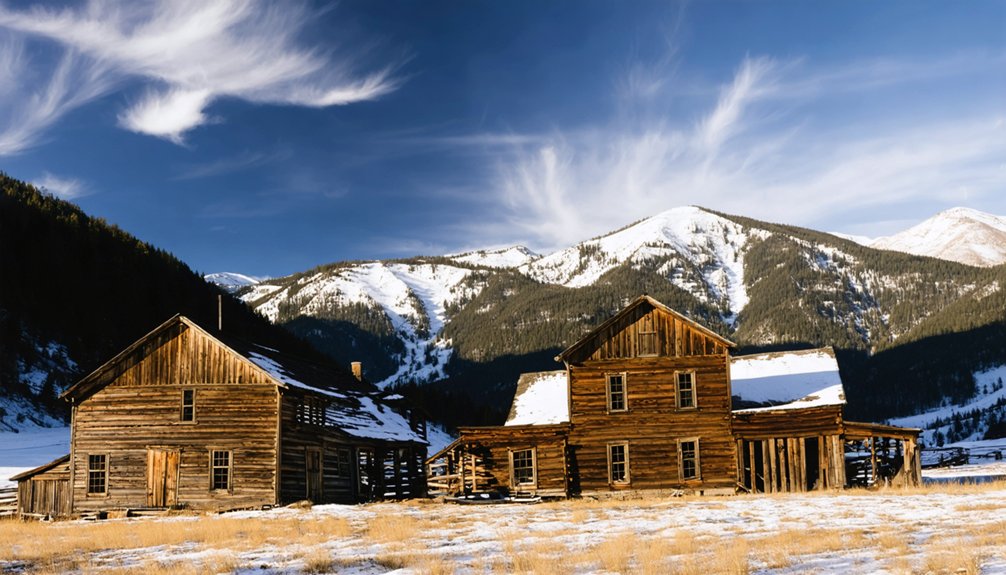You’ll discover Animas Forks nestled at 11,200 feet in Colorado’s San Juan Mountains, where it thrived as a silver mining community from 1873 to 1915. At its peak in the 1880s, the town supported 1,500 residents with amenities including a post office, school, and the grand Kalamazoo House hotel. Today, this well-preserved ghost town showcases restored structures from its mining heyday, though you’ll need a 4WD vehicle to navigate the challenging mountain terrain. The site’s remarkable history holds fascinating tales of survival at extreme altitudes.
Key Takeaways
- Animas Forks is an abandoned mining town in Colorado established in 1873, reaching its peak population of 1,500 during the mining boom.
- Located at 11,200 feet elevation, the town was built after gold and silver discoveries but was frequently abandoned during harsh winters.
- The town features preserved historic structures including the two-story Duncan House and remains of the first structural steel mill in Colorado.
- Listed on the National Register of Historic Places in 1980, Animas Forks now attracts 250,000 annual visitors as a tourist destination.
- The town’s decline began with the 1893 silver crash, culminating in complete abandonment by 1917 after mine closures.
The Birth of a Mining Frontier
When prospectors discovered rich deposits of gold and silver in 1873, they established what would become one of the earliest settlements in Colorado’s San Juan Mountains. Originally called Three Forks of the Animas River, the first log cabin emerged at a staggering elevation of 11,200 feet, marking the beginning of a resilient frontier community. The town gained official status with a post office established in February 1875.
You’ll find that mining techniques evolved quickly as the town’s reputation grew, attracting fortune seekers from across the region. By 1876, the settlement had transformed into a bustling hub with 30 cabins, while Otto Mears’ strategic construction of wagon roads in 1875 connected Animas Forks to Ouray and Lake City.
This essential infrastructure enabled daily stagecoach service, bringing new investors, supplies, and opportunities to this ambitious mountain outpost. The town reached its peak during the 1880s when the population swelled to 450 summer residents.
Life at 11,200 Feet: A Rocky Mountain Community
Despite its breathtaking alpine setting, life in Animas Forks tested the limits of human endurance at 11,200 feet elevation. You’d find yourself battling blizzards that could last 23 days, with snow accumulating to depths of 25 feet, forcing you to dig tunnels between buildings just to reach your neighbors.
At 11,200 feet, Animas Forks residents endured brutal blizzards and towering snowdrifts, carving tunnels through snow just to reach their neighbors.
The high altitude challenges meant you’d need to constantly search for firewood to heat your modest cabin and cook your meals. The town supported a thriving community with a local post office that opened in 1875. Modern amenities like electricity and telegraph made life more bearable for residents.
In this remote mountain community, you’d join about 450 fellow residents at its peak, gathering at the local saloon, hotel, or general store.
When winter’s grip tightened, you’d likely join the seasonal migration to warmer Silverton, demonstrating the community’s resilience in adapting to nature’s harsh demands in this unforgiving alpine environment.
Mining Booms and Economic Transformations
You’ll find that Animas Forks’ mining prosperity began in 1873 when gold and silver discoveries sparked rapid development, attracting hundreds of prospectors and supporting a peak population of 450 by 1883.
The town’s growth accelerated through infrastructure investments, including Otto Mears’ wagon road in 1875 and the Silverton Northern Railroad’s arrival in 1896, which enhanced ore transportation and mining capabilities.
The devastating silver market crash of 1893, followed by falling metal prices in the early 1900s, triggered the town’s gradual decline, leading to the dismantling of the Gold Prince Mill by 1917 and eventual abandonment of mining operations. The harsh winters proved especially challenging, as demonstrated when a 25-foot blizzard buried the entire town in 1884.
Rise of Mining Operations
The discovery of rich gold and silver deposits in 1873 transformed Animas Forks from a remote mountain outpost into a thriving mining settlement.
You’ll find that prospector life centered around prominent operations like the Big Giant and Black Cross mines, which quickly became the backbone of the local economy.
Mining technology advanced rapidly as stamp mills, smelters, and reduction works were established to process the valuable ore.
The town reached its peak with a population of 1,500 residents during the height of mining operations.
The Gold Prince Mill, built as the first structural steel mill in Colorado, demonstrated the town’s technological advancement in ore processing.
Decline After Silver Crash
While Animas Forks flourished during its mining heyday, a devastating silver market crash in 1893 triggered the settlement’s rapid descent into abandonment. The sharp silver price fluctuations devastated the town’s primary economic activity, prompting many residents to seek opportunities elsewhere. During the severe winter of 1884, 25-foot snowfall buried the entire town and further tested residents’ resilience.
Though the Silverton Northern Railroad’s arrival in 1904 briefly sustained hope, the mining industry impact proved insurmountable. The closure of the Gold Prince Mill marked the final blow to the town’s survival.
A series of disasters compounded the economic crisis. Fires in 1891 and 1913 destroyed multiple structures, while harsh weather conditions made recovery even more challenging.
Surviving the Elements: Weather and Adaptation
Situated at an elevation of approximately 11,200 feet, Animas Forks endures some of Colorado’s most extreme weather conditions, with average annual temperatures hovering around 34.6°F and dramatic seasonal variations.
You’ll find temperatures plummeting to -7.6°F in winter and reaching 80.6°F during brief summers, while freezing conditions can occur year-round. Weather impacts on the historic structures are severe, evidenced by sagging roofs and splintered siding from relentless freeze-thaw cycles.
The town’s original residents developed structural adaptations to combat these harsh elements. They reinforced buildings against heavy snow loads and fierce winds, while creating climate-controlled interiors. The region receives an impressive 128.6 inches of snowfall annually.
Today, preservation efforts focus on protecting wooden structures from moisture infiltration and temperature fluctuations, ensuring these remnants of the past continue standing against mountain weather’s constant assault.
The Town’s Golden Era: 1880s Peak Years

During Animas Forks’ golden age in the 1880s, you’d find a bustling town of 450 summer residents supported by thriving gold and silver mining operations.
You could witness the town’s impressive development through its incorporation in 1881, complete with numbered streets, multiple saloons, a hotel, and the *Animas Forks Pioneer* newspaper serving the community from 1882 to 1886.
The town’s infrastructure expanded notably during this period with Otto Mears’ wagon toll road connecting to Ouray and Lake City, enabling essential stagecoach service for commerce and mail delivery.
Population and Economic Growth
As prospectors discovered rich silver and gold deposits in 1873, Animas Forks transformed from a small settlement into a thriving mining community, reaching a population of 450 by the mid-1880s during summer months.
Mining families and workers supported a diverse economy that included multiple businesses, from general stores to assay offices. The harsh winters drove seasonal migration, with many residents relocating to nearby Silverton until spring’s return.
- The town’s economic backbone consisted of major mines like Gold Prince, Columbus, and Red Cloud, supporting ancillary industries and stamp mills.
- Commercial growth included three general stores, two butcher shops, boarding houses, and the prominent Mercer House hotel.
- Otto Mears’ 1875 toll wagon road connected Animas Forks to neighboring communities, facilitating trade and transportation of ore.
Thriving Community Infrastructure
While silver and gold mining drove Animas Forks‘ rapid growth, the town’s sophisticated infrastructure development in the 1880s marked its evolution into a permanent settlement.
You’d find a bustling community with essential services, including a post office, school, and jail, supporting year-round residents’ needs. At the heart of community health and cultural events stood the grand Kalamazoo House hotel, boasting the town’s only telephone and piano.
The *Animas Forks Pioneer* newspaper kept citizens informed from 1882 to 1886, while multiple general stores, a butcher shop, and restaurants served daily needs.
A water-powered sawmill, producing 4,000 board feet daily, enabled the shift from basic log cabins to more sophisticated wooden structures, reflecting the town’s growing prosperity and permanence.
Decline of a Mountain Settlement
Despite its promising start as a thriving mining settlement, Animas Forks began a steep decline in the late 19th century due to multiple devastating setbacks. The community’s resilience was tested through severe challenges that ultimately proved insurmountable:
Once a booming frontier town, Animas Forks succumbed to fate as crushing setbacks gradually eroded its mining prosperity.
- Natural disasters struck hard – an 1877 avalanche destroyed crucial infrastructure, while brutal winters, including an 1884 blizzard dropping 25 feet of snow, forced seasonal abandonment.
- Economic blows came fast – the 1893 silver market crash crippled mining profits, while the Gold Prince Mill’s 1910 closure signaled dwindling opportunities.
- Infrastructure crumbled steadily – the post office’s 1915 closure, followed by the dismantling of mining equipment by 1917, marked the settlement’s struggles.
Ghost Town Legacy and Preservation

Today, Animas Forks stands as a carefully protected historic treasure, having earned its place on the National Register of Historic Places in 1980 and renewed recognition in 2011.
The San Juan County Historical Society and Bureau of Land Management jointly oversee its preservation, securing grants for essential restoration work.
You’ll find remarkable preservation challenges at this high-altitude site, where approximately 250,000 annual visitors and harsh mountain weather threaten the historic structures.
Despite vandalism, including graffiti and theft of historic materials, dedicated preservationists have implemented significant stabilization efforts since the 1970s.
Recent federal grants have funded essential structural repairs to maintain the site’s historical significance.
The ghost town now serves as an open-air museum, offering you direct insight into 19th-century mining life through its surviving cabins, commercial buildings, and mining infrastructure.
Planning Your Visit to Animas Forks
Successful exploration of Animas Forks requires thoughtful planning and preparation, particularly given its remote location at 11,200 feet elevation in Colorado’s San Juan Mountains.
You’ll need to carefully consider both access tips and seasonal considerations before commencing on your journey through this historic mining settlement.
For ideal exploration of this remarkable ghost town, follow these essential guidelines:
- Plan your visit during summer months (late June through early September) when roads are snow-free and weather conditions are most favorable.
- Drive a high-clearance 4WD vehicle, as the 12-mile unpaved road from Silverton demands skilled navigation.
- Pack emergency supplies, including water, food, warm clothing, and maps, as cell service is limited and weather changes rapidly at high altitude.
Frequently Asked Questions
Are There Any Reported Hauntings or Paranormal Activities in Animas Forks?
You won’t find any documented ghostly sightings or spectral legends at this location. While its abandoned structures create an eerie atmosphere, there’s no credible evidence of paranormal activity in historical records.
Can Visitors Take Artifacts or Rocks From the Site?
Just as you wouldn’t steal memories from someone’s home, you can’t take artifacts or rocks here. It’s illegal under federal law, with strict legal restrictions protecting artifact preservation.
What Wildlife Encounters Are Common Around the Ghost Town?
You’ll likely encounter moose near the river, elk in valley areas, and beavers around waterways. Wildlife sightings include bald eagles hunting overhead, while black bears demonstrate cautious animal behavior in surrounding wilderness.
Is Camping Allowed Within the Animas Forks Town Site?
You’d need a million permits to camp within the town site itself. While dispersed camping is allowed on surrounding BLM land, there aren’t any site amenities and camping regulations protect historic structures.
Are There Guided Tours or Interpretive Programs Available at Animas Forks?
You’ll find multiple guided exploration options with professional guides who detail the site’s historical significance through 2.5-hour tours, including Jeep, ATV, and off-road vehicle excursions from $89-129 per person.
References
- https://www.durango.com/animas-forks/
- https://www.legendsofamerica.com/animas-forks-colorado/
- https://en.wikipedia.org/wiki/Animas_Forks
- https://savingplaces.org/stories/ghost-of-a-chance-animas-forks-colorado
- https://janmackellcollins.wordpress.com/2025/01/13/a-visual-history-of-animas-forks-colorado/
- https://www.airial.travel/attractions/united-states/silverton/animas-forks-ghost-town-colorado-fopIjADl
- https://www.blm.gov/visit/animas-forks
- https://www.youtube.com/watch?v=OyzOrahxgPE
- https://westernmininghistory.com/towns/colorado/animas-forks/
- https://www.youtube.com/watch?v=r1_pnNhNWxY



